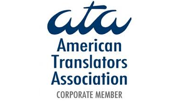August 24, 2017 by admin
Get a Free Quote
Our Accreditations





Recent Updates
Culture-bound syndromes and how language shapes illness
In her book Sleeping Beauties, neurologist Suzanne O’Sullivan explores the phenomenon of culture-bound illnesses around the world. The conditions she is interested in are psychosomatic disorders which arise due to a complex interaction between the mind and body, but… Read More
Any translator working from French or German to English or vice versa will surely have cursed softly under their breath at the different number conventions used in these languages for writing out numbers. Where US and British English use a full stop/period to do the job of marking the decimal place, most other European languages use a comma.
And then to confound things still further English deploys the comma as the thousands separator while German and many other languages use the period here. If numbers are contained in tables of figures, a three stage search and replace task can take care of the formatting conversion. So for a recent German financial report I worked on, each of the many tables was put through the following steps.
1. Find “.” and replace with some reasonably unusual character, I chose “!”
2. Find “,” and replace with “.”
3. Find your chosen character from step 1 “!” and replace with “,”
This can be done fairly speedily where numbers are in tabular format, however, where numbers are scattered through the main body of the text there is often nothing for it but to manually reformat each one as appropriate. That’s unless you are really tech savvy and fancy doing some kind of regular expression-based search and replace operation to target the “.” and “,” exclusively contained in number sequences.
Not content with swapping around the punctuation marks used for the decimal and thousands separators, some European languages use a space to indicate the thousands separator. I’ve also tackled plenty of Swiss German documents which use the apostrophe or raised comma for exactly the same purpose. So you might have a Swiss Francs value given as CHF 1’365’400,72 or even CHF 1’365’400.72.
Once you’ve sorted out the number formatting, you are then faced with the vexed issue of where to put the currency symbol. The Brits firmly lead with their £ symbol ahead of the quantity, as do the Americans with the $. The Europeans are rather more confused and pretty much anything goes. The French, Germans, Italians and Spanish have a tendency to place the € sign after the quantity, the Dutch and Irish, on the other hand, are more likely to place the € symbol before the number. In each case the decision is likely influenced by the relevant number convention in each country prior to joining the Euro zone.
The French, Germans, Italians and Spanish have a tendency to place the € sign after the quantity, the Dutch and Irish, on the other hand, are more likely to place the € symbol before the number. In each case the decision is likely influenced by the relevant number convention in each country prior to joining the Euro zone.
And just when you think you’ve finished tearing your hair out and can get back to the task of translating some text, along comes the zero to throw a spanner in your works. Several European countries seem to have taken against the zero and like to replace it with a hyphen, either before or after the decimal point: €–.05 or CHF 52,-! The exclamation mark is mine, by the way.
Get a Free Quote
© 2024 All Rights Reserved
Rosetta Translation, 133 Whitechapel High St, London E1 7QA · 0207 248 2905
Comments
Add Comment